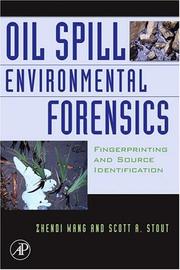| Listing 1 - 2 of 2 |
Sort by
|

ISBN: 0128096594 1280746920 9786610746927 0080467733 0123695236 0128039027 9780080467733 9780123695239 9780128039021 9780128096598 9780128038321 0128038322 9780128096598 Year: 2016 Publisher: London : Academic Press,
Abstract | Keywords | Export | Availability | Bookmark
 Loading...
Loading...Choose an application
- Reference Manager
- EndNote
- RefWorks (Direct export to RefWorks)
Oil Spill Environmental Forensics provides a complete view of the various forensic techniques used to identify the source of an oil spill into the environment. The forensic procedures described within represent various methods from scientists throughout the world. The authors explore which analytical and interpretative techniques are best suited for a particular oil spill project. This handy reference also explores the use of these techniques in actual environmental oil spills. Famous incidents discussed include the Exxon Valdez incident in 1989 and the Guanabara Bay, Brazil 2000. The
Oil spills --- Environmental forensics. --- Pollution --- Environmental aspects. --- Measurement. --- Environmental forensics --- Environmental monitoring --- Chemistry, Forensic --- Environmental chemistry --- Environmental law --- Measurement --- Environmental chemistry. --- Chemistry, Environmental --- Chemistry --- Ecology --- Handbooks and manuals.
Digital
ISBN: 9780128039021 0128039027 0128096594 9780128096598 Year: 2016 Publisher: London Academic Press
Abstract | Keywords | Export | Availability | Bookmark
 Loading...
Loading...Choose an application
- Reference Manager
- EndNote
- RefWorks (Direct export to RefWorks)
Standard Handbook Oil Spill Environmental Forensics: Fingerprinting and Source Identification, Second Edition, provides users with the latest information on the tools and methods that have become popular over the past ten years. The book presents practitioners with the latest environmental forensics techniques and best practices for quickly identifying the sources of spills, how to form an effective response, and how to determine liability. This second edition represents a complete overhaul of the existing chapters, and includes 13 new chapters on methods and applications, such as emerging application of PAHi isomers in oil spill forensics, development and application of computerized oil spill identification (COSI), and fingerprinting of oil in biological and passive sampling devices.
| Listing 1 - 2 of 2 |
Sort by
|

 Search
Search Feedback
Feedback About UniCat
About UniCat  Help
Help News
News